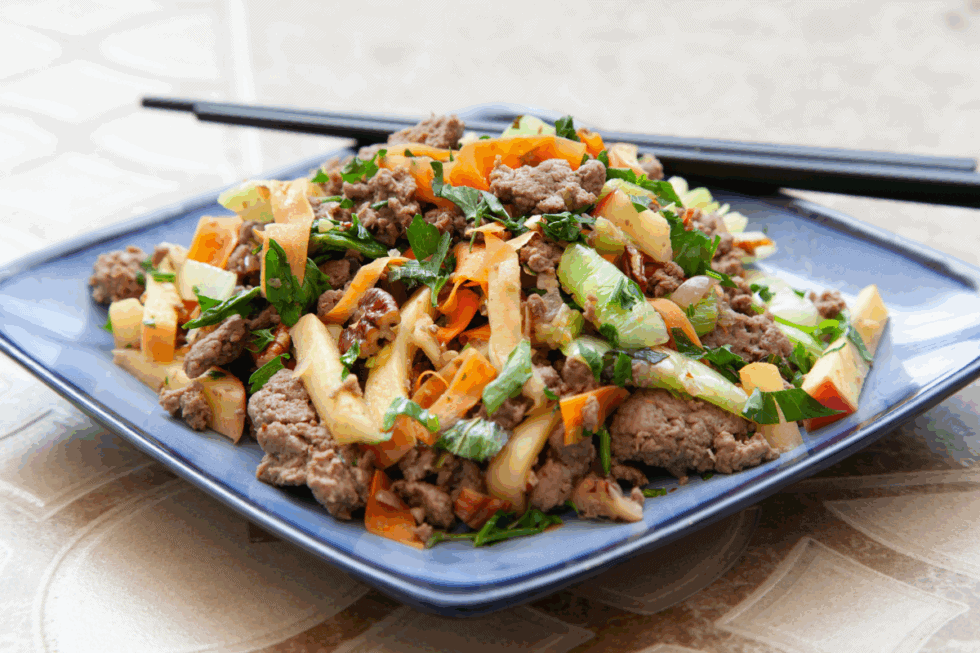
Low Histamine, High Protein Foods: Low Histamine Bison Egg Roll Bowl Recipe (also Low Oxalate and Low Lectin)
Low histamine, high protein foods help keep your body functioning well.
But what if you haven’t been tolerating animal proteins like chicken and beef?
Even though these meats are on the low histamine foods list, there are several reasons you might be reacting.
You’ll read more on that coming up.
You’ll learn why eating meat from sources outside what might be your norm can help you get protein back in your diet, too.
We’ve got an easy, tasty recipe for you to check out featuring one of our favorite lean meats, bison.
Have you tried bison yet?
It’s gotten some popularity in the form of bison burgers. But there are many ways you can cook it.
Our recipe for a bison egg roll bowl is simple and tasty.
You’ve probably heard of a burrito bowl. It’s basically all the filling of a burrito without a wheat or corn tortilla.
An egg roll bowl is the same idea. No wrapper but all the tasty filling.
We were inspired to create this low histamine bison egg roll bowl by an idea we saw on Northstar Bison’s website.
If you’ve tried our low histamine spring roll stir fry, you might like this dish, too.
But this recipe is different, starting with the protein. And we’ve used a variety of herbs and veggies, along with apples and pecans for a unique twist.
This recipe is:
- Low histamine
- Low oxalate
- Low lectin
- Dairy free
- Gluten free
Keep reading to get the recipe and learn more about:
- Choosing low histamine meat
- The importance of protein for your health
- How changing proteins can help with reactivity
- Tips for cooking bison
- Your coupon code for 10% off Northstar Bison orders
Low Histamine, High Protein Foods
Before you change your diet on your own, please make sure you’re working with a healthcare professional who can help you with this. Never limit foods unnecessarily, and always have a licensed medical provider who is supervising your case.
If you’re reading this blog, you’re probably dealing with Histamine Intolerance or other food intolerances. You may be dealing with Mast Cell Activation Syndrome, too.
Following a low histamine diet is one of the first steps to lowering your histamine levels.
The low histamine diet is a type of elimination diet where you focus on eating low histamine foods instead of high histamine foods.
A healthcare provider like a nutritionist or dietitian can help you achieve well balanced meal plans with lower histamine content.
There are many foods to choose from while on the low histamine diet.
But here’s what you need to know about levels of histamine in protein like fresh meat.
Generally, we say “fresh is best.” But when it comes to meat, your “fresh meat” may not be as fresh as you think!
Do you still have symptoms of Histamine Intolerance even when eating low histamine chicken, for example?
Here’s more on that.
Choosing Low Histamine Meat
Several animal-based proteins are considered low histamine foods.
A few examples include:
- Chicken
- Salmon
- Unaged Bison
- Unaged Beef
- Rabbit
- Lamb
- Turkey
- Halibut
Some examples of animal-based proteins that are high histamine foods include:
- Aged beef or bison
- Processed meats
- Pre-ground meats
- Cured meats
- Some shellfish
But the type of meat itself is only one factor when it comes to histamine levels or mast cell triggers.
How it’s raised, processed, shipped, and stored also matters.
All of these factors can potentially contribute to your reactions, especially for those who are very sensitive.
You can learn more in our article, The Best Meat and Seafood Options.
But for now, here’s a quick guide to what you should look for if you’re dealing with Mast Cell Activation Syndrome (MCAS) or Histamine Intolerance.
Choose meats that are:
- Hormone and Antibiotic Free
- Organically Raised
- Preservative Free
- Soy-Free
- Corn-Free
- Gluten-Free
- Glyphosate-Free
- Frozen soon after harvest and processing. This minimizes bacteria growth and helps keep histamine levels low.
That’s why Northstar is one of our favorite suppliers.

>>> Click here and use code MASTCELL360 to save 10% on Low Histamine Meat from NorthStar Bison
They tick all those boxes. Additionally, their animals are raised in their native environment and humanely harvested.
And their bison is 100% grass fed!
Did you know that bison should never taste gamey? It should taste clean and slightly sweet.
A lot of the gamey flavor people experience with bison is a result of animals that are significantly older when harvested, or from stress and poor living conditions and diet.
But why is protein so important?
Read on to find out.
The Importance of Low Histamine Protein for Good Health
The Dietary Guidelines for Americans recommends 46 grams of protein per day for adult women. For adult men, the recommendation is 56 grams.
These are general guidelines. And it looks like a lot!
But below are a few examples of common foods and their approximate protein content in grams.
You’ll see you have many ways to get protein in your diet.
Please note that these are low histamine foods, but some may not be low oxalate or low lectin. We’ve marked foods high in these as O and L.
Click food lists to see all our lists including FODMAPs and salicylates.
- 3-ounce piece of chicken — 20 grams
- 4-ounce serving of bison — 23 grams
- 3-ounce serving of salmon — 17 grams
- 1 egg — 6 grams
- 1 egg white — 3.6 grams
- ¼ cup ricotta cheese — 6 grams
Many plant-based foods have some protein content, too.
- 1 cup of broccoli — 2.5 grams
- ½ cup of cooked lentils — 12 grams (L, O)
- 1 cup chickpeas — 10 grams (O)
- 1 cup cooked quinoa — 8 grams (L, O)
- 1 cup coconut milk — 5 grams
- 1 sweet potato — 2 grams (O)
- 1 ounce of chia seeds — 4 grams
- ¼ cup macadamia nuts — 2.5 grams (O, if over ¼ cup)
- ¼ cup pistachios — 5 grams (O, if over ¼ cup)
Legumes tend to have the most protein. They usually fall in the oxalate or lectin category, though.
But you can see that eating a wide range of vegetables, even with lesser amounts of protein, can still add up!
But why is protein so important, especially if you have Mast Cell Activation Syndrome (MCAS) or Histamine Intolerance?
Protein for Mast Cell Activation Syndrome (MCAS) and Histamine Intolerance
Protein plays so many important roles in your body.
Proteins function as building blocks for:
- Bones
- Muscles
- Cartilage
- Skin
- Blood
Some of the functions and benefits of protein and the amino acids (the building blocks of proteins) include:
- Energy production
- Aid in weight loss / management
- Repairing injury
- Carrying oxygen throughout the body
- Digestion and gut health
- Hormone regulation
And protein plays a key role in the growth, renewal, and healing process in your cells.
Importantly, it’s beneficial for your mast cells.
The amino acids that make up proteins support mast cell function.
Some studies have shown that they can modulate mast cell activation by influencing signaling pathways.
And certain amino acids have been shown to have anti-inflammatory properties.
Since mast cell activation and histamine release can both create inflammation, this is beneficial for those with MCAS or Histamine Intolerance.
Further, mast cells are part of your immune system. And your immune system needs protein to function effectively.
And did you know that protein plays a role in making the DAO enzyme (diamine oxidase) in your body?
DAO is the histamine reducing enzyme in your body. It functions as a kind of antihistamine.
Many people with Histamine Intolerance don’t make enough of it. This can be a contributing factor to high histamine levels in the body.
You can see why protein is important. Especially as you heal from MCAS and Histamine Intolerance.
But what if you are reacting to your go-to protein sources?
Switching Proteins to Help with Food Reactions
You read earlier that part of the reason you may be reacting to meats that are typically considered low histamine may not be the food itself.
Some “low histamine foods” may have higher histamine levels, trigger mast cells, or have inflammatory properties due to factors like:
- How the meat is raised (growth hormones, antibiotics, type of feed)
- How the meat is processed (stressful conditions which release stress hormones in the animal, aging processed meat for flavor)
- How the meat is stored and shipped (not frozen right after processing)
- The age of the meat when you buy it (increased bacteria)
- The amount of surface area for bacteria to grow (think ground meat vs a roast)
Additionally, we know that if you also have Mast Cell Activation Syndrome (MCAS), your mast cells can be overly responsive.
They can react to even “safe” things like certain foods, supplements, or medications.
This means that even if you don’t have a true food allergy, you may still experience reactions.
So, what can be done about this in regard to maintaining protein in your diet?
Studies are ongoing, but rotating low histamine foods may be beneficial.
Rotation diets typically involve eliminating potential food triggers and then slowly reintroducing them.
They may also involve trying new foods to make sure you are getting proper nutrition from your diet.
Working with a healthcare provider and keeping a food diary is a good place to start identifying potential food triggers.
Eliminating food triggers gives your body time to process and eliminate any substances that may trigger your symptoms.
But we like to emphasize replacing rather than eliminating. Simply eliminating foods can leave you with nutritional deficiencies.
Proper nutrients are needed to support your immune system (including mast cells).
Instead, focus on anti-inflammatory and nutrient-dense, low histamine foods.
Reducing inflammation can help calm mast cell reactions and potentially improve symptoms.
If you’ve been reacting to low histamine meats like chicken or turkey, you can try a different low histamine meat.
If you are super sensitive, we still recommend starting with just a few bites of any new food.
You can make half a recipe, take a few bites alongside known “safe” foods, and freeze the rest until you know you can tolerate it.
Interested in trying bison?
Here are some quick tips to know about cooking bison.
Tips for Cooking Low Histamine Bison
Bison is much leaner than beef.
Because it’s so lean, the cooking time for bison is less than for beef.
Related Post: Low Histamine Beef: Pan Seared Filet Mignon Recipe
And overcooking can make it tough and dry.
Since this might be your first encounter with bison meat, we wanted to make a recipe that was pretty forgiving.
Bison steaks can be overcooked fairly easily, we’ve discovered.
But when the bison is ground and mixed with other nutritious produce, you’ve got a little leeway.
Northstar does offer ground bison. If you aren’t as sensitive, you may do fine with this.
However, pre ground meats tend to be higher histamine due to an increase in surface areas for bacteria to grow.
So, if you are sensitive, you may want to grind your own.
We started with a good quality sirloin tip roast and ground our own. You can use any of the low histamine bison options you prefer.
If you don’t have a meat grinder, you can use a food processor with the s-blade. Pulse until ground well.
The sirloin steak was 2 pounds, so you’ll have leftover meat.
You can also use ground bison to make tacos, meatballs, or even a bison burger patty.
The internal temperature of ground bison when cooked should be 160° F.
We love Northstar Bison for a number of low histamine meats.
And as you see, “bison” is even in their company name! You can really count on them for excellent bison products!
>>> Click here and use code MASTCELL360 for 10% off at Northstar Bison
What to Serve with Low Histamine High Protein Bison Egg Roll Bowl
- Asparagus with Garlic and Ginger Sauce – Low Histamine, Low Oxalate, Low Lectin
- Chinese Broccolini Recipe Inspired by Gai Lan Chinese Broccoli – Low Histamine, Low Oxalate, Low Lectin, Low FODMAP
- Easy Mango Ice Cream – Low Histamine, Low Oxalate, Low Lectin
- Fresh Fruit Cobbler – Low Histamine, Medium Oxalate, Low Lectin
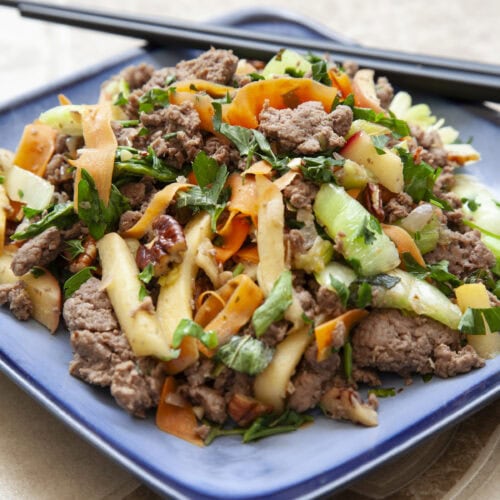
Low Histamine High Protein Bison Egg Roll Bowl
Equipment
- Sharp Knife
- Meat Grinder OR
Ingredients
- 2 Tablespoons Kasandrino’s Olive Oil
- 1 pound Bison ground
- 1 Tablespoon Toasted Sesame Oil
- ¼ teaspoon Redmond Real Salt
- 4 Tablespoons Shallot minced
- 2 teaspoons Garlic minced
- 1 teaspoon Organic Fresh Ginger grated
- ½ cup Carrots shaved (omit or lessen if oxalate sensitive)
- 4 cups Baby Bok Choy about 2 heads
- ½ cup Organic Apples julienned (about ½ of an apple)
- 2 Tablespoons Green Onion
- 2 Tablespoons Fresh Organic Flat Leaf Parsley
- 2 teaspoons Fresh Mint
- 4 Tablespoons Pecans chopped
Instructions
- Wash and prep the produce as indicated above. For the carrots, remove the bitter peel / skin with a peeler and discard. Continue using the peeler to get ribbons of carrots for shaved carrots.
- Add olive oil to a large skillet and heat over medium heat.
- Add the ground bison and cook until browned through (about 2 to 3 minutes). When cooked, set it aside on a plate.
- In the same pan, add the sesame oil, shallots, garlic, ginger, carrots, bok choy, apple, and green onion. Cook for about 2 minutes until bok choy and carrots just start to wilt. They should still be bright and colorful with some bite.
- Then add back in the bison, parsley, mint, and pecans and stir to combine, about 30 seconds.
Notes
Nutrition
What other low histamine high proteins would you like us to feature in upcoming recipes?
More Low Histamine, High Protein Recipes
- Breakfast Casserole – Low Histamine, Low Oxalate, Low Lectin, Low FODMAP
- Chicken with Green Sauce – Low Histamine, Low Oxalate, Low Lectin
- Macadamia Crusted Fish – Low Histamine, Medium Oxalate, Low Lectin, Low FODMAP
The website provides approximate nutrition information. Users should calculate the nutritional information with the actual ingredients and quantities they use in their recipes for the most accurate representation.
Some links in this website are affiliate links, which means Mast Cell 360 may make a very small commission if you purchase through the link. It never costs you any more to purchase through the links, and we try to find the best deals we can. We only recommend products that we love and use personally or use in the Mast Cell 360 practice. Any commissions help support the newsletter, website, and ongoing research so Mast Cell 360 can continue to offer you free tips, recipes, and info. Thank you for your support!
References
Hamilton, M. J., Scarlata, K., & Carol Rees Parrish, MS, RDN. (2020). Mast cell activation syndrome – what it is and isn’t. Practical Gastroenterology. https://med.virginia.edu/ginutrition/wp-content/uploads/sites/199/2020/06/Mast-Cell-Activation-Syndrome-June-2020.pdf
HappyForks. (n.d.). Recipe analyzer. https://happyforks.com/analyzer
Kaag, S., & Lorentz, A. (2023). Effects of dietary components on mast cells: possible use as nutraceuticals for allergies?. Cells, 12(22), 2602. https://doi.org/10.3390/cells12222602
Kelley, K. W., Weigent, D. A., & Kooijman, R. (2007). Protein hormones and immunity. Brain, Behavior, and Immunity, 21(4), 384–392. https://doi.org/10.1016/j.bbi.2006.11.010
MyPlate.gov | Protein Foods Group – one of the five food groups. (n.d.). https://www.myplate.gov/eat-healthy/protein-foods
Nair, K. S., & Short, K. R. (2005). Hormonal and signaling role of branched-chain amino acids. Journal of Nutrition, 135(6), 1547S-1552S. https://doi.org/10.1093/jn/135.6.1547s
Ostrowska, L., et al. (2021). Igg food antibody guided elimination-rotation diet was more effective than FODMAP diet and control diet in the treatment of women with mixed IBS-results from an open label study. Journal of Clinical Medicine, 10(19), 4317. https://doi.org/10.3390/jcm10194317
USDA. (2020). Dietary guidelines for Americans. In dietaryguidelines.gov (USDA-FNS-2020-2025-DGA). Retrieved June 28, 2025, from https://www.dietaryguidelines.gov/sites/default/files/2020-12/Dietary_Guidelines_for_Americans_2020-2025.pdf
Wang, X., et al. (2022). The Effect of a Compound Protein on Wound Healing and Nutritional Status. Evidence-based complementary and alternative medicine : eCAM, 2022, 4231516. https://doi.org/10.1155/2022/4231516
Witkowski, M., Grajeta, H., & Gomułka, K. (2022). Hypersensitivity reactions to food additives—preservatives, antioxidants, flavor enhancers. International Journal of Environmental Research and Public Health, 19(18), 11493. https://doi.org/10.3390/ijerph191811493
Zhao, J., et al. (2018). Dietary protein and gut microbiota composition and function. Current Protein and Peptide Science, 20(2), 145–154. https://doi.org/10.2174/1389203719666180514145437
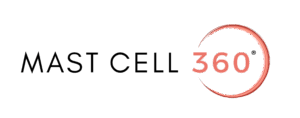

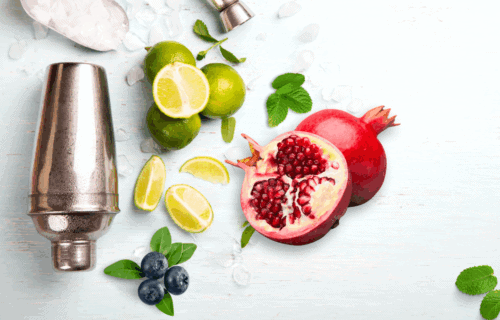
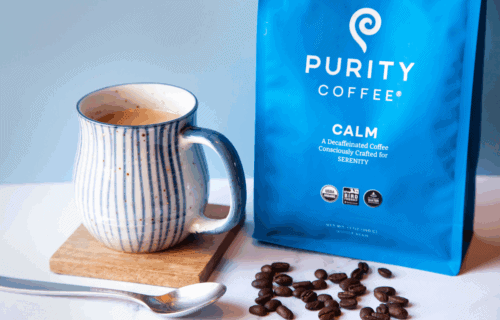
trying it now.